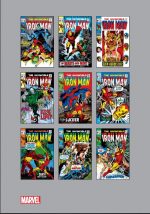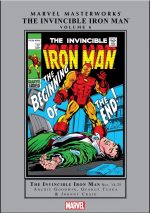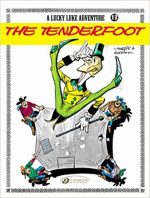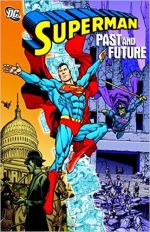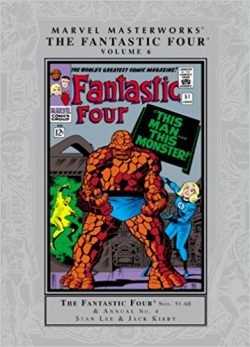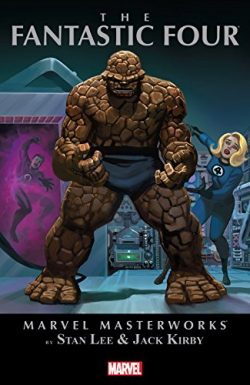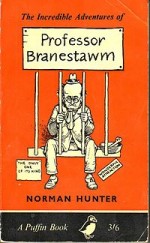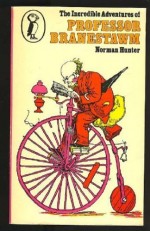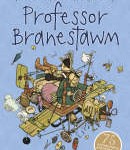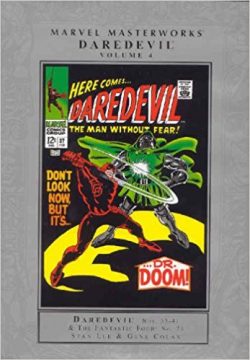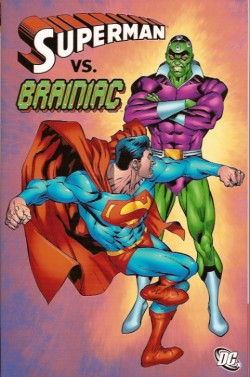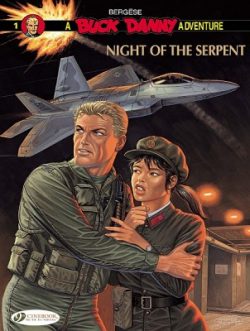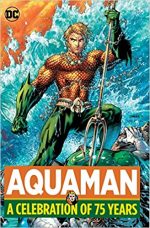
By Mort Weisinger, Joe Samachson, Jack Miller, George Kashdan, Robert Bernstein, Steve Skeates, Gerry Conway, Paul Levitz, Peter David, David Michelinie, Rick Veitch, Geoff Johns, Cullen Bunn, Paul Norris, Louis Cazeneuve, Ramona Fradon, Nick Cardy, Jim Aparo, Dick Giordano, Martin Egeland, Jim Calafiore, Yvel Guichet, Ivan Reis, Trevor McCarthy & others (DC Comics)
ISBN: 978-1-4012-6446-8
Aquaman is that oddest of comicbook phenomena: a timeless survivor. One of the few superheroes to carry on in unbroken exploits since the Golden Age, the King of the Seas has endured endless cancellations, reboots and makeovers in the name of trendy relevance and fickle fashion but somehow has always rapidly recovered to come back fresher, stronger and more reinvigorated.
He’s also one of the earliest cartoon champions to make the jump to television…
Where many stronger features foundered – and although strictly a second stringer for most of his career – Aquaman nevertheless soldiered on long after the Golden Age ended: a rather nondescript and generally bland looking chap who solved maritime crimes, rescuing fish and people from sub-sea disaster.
This stunning compilation – part of a dedicated series introducing and exploiting the comics pedigree of veteran DC icons and concepts is available in hardback and digital formats, offering an all-too-brief but astoundingly enticing sequence of tantalising snapshots detailing how Aquaman has changed like the tides yet remains as constant as the endless seas.
Collecting material from More Fun Comics #73, 89, Adventure Comics #120, 174, 220, 260, 266, 269, 444, 452, 475, Aquaman volume 1 #1, 18, 40, Justice League of America Annual #2, Aquaman volume 2 #3, Aquaman volume 4 #2, 34, Aquaman volume 5 #4, 17, Aquaman volume 6 #1, 43, cumulatively covering April 1941 to October 2015.
These groundbreaking appearances are divided into specific eras, each preceded by brief critical analyses of the significant stages in his development, beginning with Part I 1941-1961: Making a Splash…
As previously stated, Aquaman was one of the handful of costumed adventurers to survive the superhero collapse at the end of the Golden Age. He was created by Mort Weisinger and Paul Norris in the wake of and in response to Timely Comics’ Sub-Mariner, debuting in More Fun Comics #73 (November 1941) with an untitled tale latterly designated ‘The Submarine Strikes’ for this edition.
This salty sea saga sees survivors in lifeboats being rescued – and the brutal U-Boat commander responsible for their plight swiftly brought to justice – by a mysterious stranger who converses with porpoises. The golden saviour then reveals that he was made into a subsea superman by his scientist father; an explorer who had discovered all the secrets of lost, long-dead Atlantis…
Records are incomplete, sadly, so often we don’t know who wrote what, but for More Fun Comics #89 (March 1943), Louis Cazeneuve limns the marine marvel’s heated and ruthless battle against modern pirate Black Jack and ‘The Streamlined Buccaneers’, with Aquaman now commanding an army of varied sea creatures whilst ‘Aquaman Goes to College’ (Adventure Comics #120, September 1947 by Joe Samachson & Cazeneuve) sees the sea king sagaciously seeking to expand his knowledge of marine life only to become embroiled in collegiate sporting scandals…
By 1954 young Ramona Fradon (Metamorpho; Brenda Starr) had assumed the art chores, by which time Aquaman was settled like a barnacle in a regular Adventure Comics back-up slot offering slick, smart and extremely genteel aquatic action. She was to draw every single adventure until 1960, making the feature one of the best looking if only mildly thrilling hero strips of the era.
A fine example is ‘The Whale That Was Wanted for Murder’ (Adventure Comics #174, March 1952, and scripted by George Kashdan) wherein the hunt for a seemingly rogue cetacean leads our hero to a conniving smuggler…
Cover-dated January 1956, Adventure Comics #220, revealed how Aquaman saved the reputation of a disgraced naval aviator in ‘The Coward and the Hero’ (Jack Miller & Fradon) after which the Silver Age revival of superheroes caught up to the Sea King and led to a canny reboot in issue #260 (May 1959).
In 1956, Showcase #4 rekindled the public’s imagination and zest for costumed crime-fighters with a new iteration of the Flash. Enjoying a heated fan response, the editors sanctioned other re-imaginings of many departed Golden Age stalwarts, and also updated and remastered its isolated survivors, especially Wonder Woman, Green Arrow and Aquaman.
Thus, ‘How Aquaman Got His Powers’ by Robert Bernstein & Fradon, which retconned previous origins for a new tale of the offspring of a lighthouse keeper and exiled refugee from the undersea (and fully populated) city of Atlantis. Eventually all the trappings of the modern superhero followed: Themed hideout, sidekick, super-villains and even a civilian name – Arthur Curry!
Moreover, greater attention was paid to continuity and the concept of a shared universe…
In Adventure Comics #266, (November 1959) Bernstein & Fradon detailed how ‘Aquaman Meets Aquagirl!’: giving a little more information about fabled modern Atlantis whilst testing the waters (sorry!) for a possible sidekick – after all, the Sea King spent most of his time expositorially dialoguing with an octopus!
With #269, Adventure Comics #269, (February 1960) Bernstein & Fradon completed the formula by introducing permanent sidekick Aqualad. ‘The Kid from Atlantis!’ was a young, purple-eyed outcast from the mysterious city possessing the same powers as Aquaman but terrified of fish… at least until the Sea King applies a little firm but kindly psychology.
By the end of the tale the little guy has happily adapted and would help patrol the endless oceans – and add a child’s awestruck perspective to the mix – for nearly a decade thereafter.
The Sea King’s rise is charted in Part II 1962-19: The Sovereign of the Sea.
As the sixties unfolded, Aquaman was appearing as a back-up feature in Detective and World’s Finest Comics (until 1964); teamed up with Hawkman in Brave and the Bold # 51 and – following a try-out season in Showcase#30-33 – made the big jump. After two decades of continuous adventuring the marine marvel finally got his own comicbook.
Cover-dated January-February 1962, Aquaman #1 is a 25-page fantasy thriller introducing one of the most controversial supporting characters in comics lore. Pixie-like Water-Sprite Quisp was part of a strange trend for cute imps and elves that attached themselves to far too many heroes of the time, but his contributions in ‘The Invasion of the Fire-Trolls’ (by Miller & Nick Cardy) and succeeding issues were numerous and obviously calculated.
Now with his own title and soon a to be featured in the popular, groundbreaking cartoon show Superman/Aquaman Hour of Adventure, the Finned Fury seemed destined for super-stardom. Moreover, the writers and editors were happy to embrace evolution and change…
Mere months after Aquaman met extradimensional princess Mera, she became ‘The Wife of Aquaman’ (by Miller & Cardy in Aquaman #18, December 1964): one of the first superhero weddings of the Silver Age and only possible after our hero defeats her obsessive, super-powered stalker Oceanus and frees Atlantis from his despotic grip. Talk about instant responsibilities…
A few years later scripter Steve Skeates and new illustrator Jim Aparo began an epic extended tale as the Sea Lord abandoned all kingly duties to hunt for Mera after she was abducted. The lengthy quest began with her being whisked away, leaving Aquaman and Aqualad to voyage to strange, distant undersea realms and here encountering ‘Sorcerers of the Sea’ (Aquaman #40, August 1968). The saga was a compelling one but frustratingly does not continue or conclude here…
As the decade closed superhero sales tanked in favour of other genres. The Sea King was again reduced to back-up duties in other titles, but the quality of his stories remained high.
‘And Death Before Dishonor’ by Paul Levitz, Gerry Conway & Aparo comes from Adventure Comics #444 (April 1976): the first chapter in another multi-part blockbuster with Aquaman forced to abdicate the rulership of Atlantis due to a conspiracy hatched by his half-brother Orm, the Ocean Master and a mysterious political player named Karshon who replaced him as King of Atlantis. The newcomer naturally had a horrific secret to conceal, but you won’t learn it here as we skip (following a brief feature on ‘The Aquafamily’) straight to Adventure Comics #452, (August 1977) where David Michelinie & Aparo orchestrate the darkest day in Aquaman’s life as ‘Dark Destiny, Deadly Dreams’ finds him fighting both his friends and greatest foe Black Manta. Tragically, despite his greatest efforts, he fails to save the one life that means most to him…
Time and tides passed before Adventure Comics #475 (September 1980) found J.M. DeMatteis & Dick Giordano detail how the newly-reconciled Aquaman and Mera forcibly separated yet again in ‘Scavenger Hunt!’ after a subsea tech and treasure hunter attacks…
Like many good superheroes, Aquaman always maintained a strong presence in a super-team throughout all his troubles, and when they went through their own sales and popularity crisis, stepped in to guide them to calmer waters…
‘…The End of the Justice League’ (Justice League of America Annual #2, October 1984; by Conway, Chuck Patton & Dave Hunt) reveals how an attack by Martian invaders almost wrecked the World because the big gun superheroes were all occupied elsewhere. Vowing never to let it happen again, Arthur disbands the old league and goes about recruiting a new, dedicated and ever-ready team.
With the king in command, established heroes J’onn J’onzz, Zatanna, Vixen and Elongated Man relocate to Detroit picking up trainee titans Steel, Vibe and Gypsy to fill out a street-level roster short on power but packed with potential…
Part III 1986-2010: The Return of the King covers a period of almost constant change and revision with the backstory of Atlantis and the Sea King regularly tweaked in search of a winning formula. In truth, the creators frequently succeeded but could never maintain the high sales each reboot started with, even after Crisis on Infinite Earths cleared away much of the five decades of accumulated backstory…
Aquaman volume 2 was a 4-issue miniseries redefining the relationship of Arthur and his half-brother Orm, as well as solidly embedding magic as a key component of previously super-rationalist Atlantis. Sporting a new costume, Aquaman endured a revised origin in #3, (April 1986 by Neal Pozner, Craig Hamilton & Steve Montana) whilst trying to stop Ocean Master subjugating Earth with lost Atlantean necromancy…
In Aquaman volume 4 #2, (September 1994) Peter David, Martin Egeland & Brad Vancata took drastic steps to make readers notice the Sea Lord and his new paramour Dolphin, as ‘Single Wet Female’ revealed the hero’s defeat of super-psychos Scylla and Charybdis and the awful cost… his left hand…
Soldiering on with a fancy multi-purpose prosthetic against ever-more incredible adversaries, Arthur faces next ‘One on One’ (by David, Jim Calafiore & Peter Palmiotti from Aquaman volume 4 #34, July 1997) jealous junior sea god Triton who learns not to take out his daddy issues against the superhero…
A new millennium and another spin as Rick Veitch, Yvel Guichet, Josh Hood, Mark Propst & Sean Parsons indulge the exiled Sea King’s mythical side as the legendary Lady of the Lake replaces that prosthetic hand with an appendage grown from magic water and tasks this King Arthur with protecting the life-sustaining Secret Sea from human exploitation and demonic contamination in ‘The Sorcerer’s Apprentice’ (Aquaman volume 5 #4, May 2003).
Still looking for a solid subsea scenario for the unflinching hero, Will Pfeifer, Patrick Gleason & Christian Alamy then return to strict scientific methodology for Aquaman volume 5 #17 (June 2004) as ‘American Tidal Part Three’ finds Arthur helping the citizens of a Californian city suddenly turned into water-breathers by a mystery maniac who also explosively submerged their homes to create Sub Diego. Helping him solve the mystery whilst adapting to her own status as the newly-minted Aquagirl is feisty millennial teen Lorena…
Wrapping up the superhero salvage voyage is Part IV 2011-2015: Twenty-First Century Aquaman concentrating on a back-to-basics Sea Sovereign and Atlantean Overlord created in the wake of the Flashpoint publishing event and DC’s company-wide reboot The New 52.
Crafted by Geoff Johns, Ivan Reis & Joe Prado, Aquaman volume 6 #1 (November 2011) saw Aquaman and Mera attempting to reconcile their status as second-string heroes on the surface world and unwelcome rulers of a belligerent Atlantis eager to wipe out air-breathing humanity. However, those petty tensions were about to be sidelined as unknown deep-sea horrors attack above and below the waves; consuming everything in their path in ‘The Trench Part One’…
As the New 52 reboot staggered to an ignominious early close, the fresh, amped-up Aquaman underwent another retrofit and re-imagining, emerging with a new costume to oppose an invasion from another reality even as his beloved Mera turned on him. Leading an army of fantastic monsters, the Sea King battled to thwart a ‘Gospel of Destruction’ (Aquaman volume 6 #43, October 2015 by Cullen Bunn, Trevor McCarthy & Jesus Merino) with the only certainty being another company wide root-&-branch retrenchment. DC Rebirth was in the offing…
Supplemented with a cover gallery by Cardy, Aparo, Brian Bolland, Craig Hamilton & P. Craig Russell, Martin Egeland & Brad Vancata, Jim Calafiore & Mark McKenna, Yvel Guichet & Mark Propst, Alan Davis & Mark Farmer, Ivan Reis & Joe Prado and Trevor McCarthy, this peek at the perpetually renewable Marine Monarch is a book of many flavours and textures.
DC has a long, comforting history of genteel, innocuous yarn-spinning delivered with quality artwork. The pre-Crisis Aquaman was a trusty champion and family friendly average guy, who became an earnest, unsure and strident wanderer in the latter part of the 20th century. In recent years he operated as a bombastic, bludgeoning brute with a chip on his shoulder and plenty to prove: proving that the Sea King is certainly a man for all generations, eras and seasons.
What is most clear however, is that his past adventures are all worthy of far more attention than they’ve received of late. It is a total pleasure to find just how readable they still are. With tumultuous sea-changes always in store for Aquaman, the comics industry and America itself, this monolithic testament to the inestimable value of a good bad-guy is a true delight for fans of all ages and vintage.
© 1941, 1943, 1947, 1952, 1956, 1959, 1960, 1962, 1964, 1968, 1976, 1977, 1980, 1984, 1986, 1994, 1997, 2003, 2004, 2011, 2015, 2016 DC Comics. All Rights Reserved.

